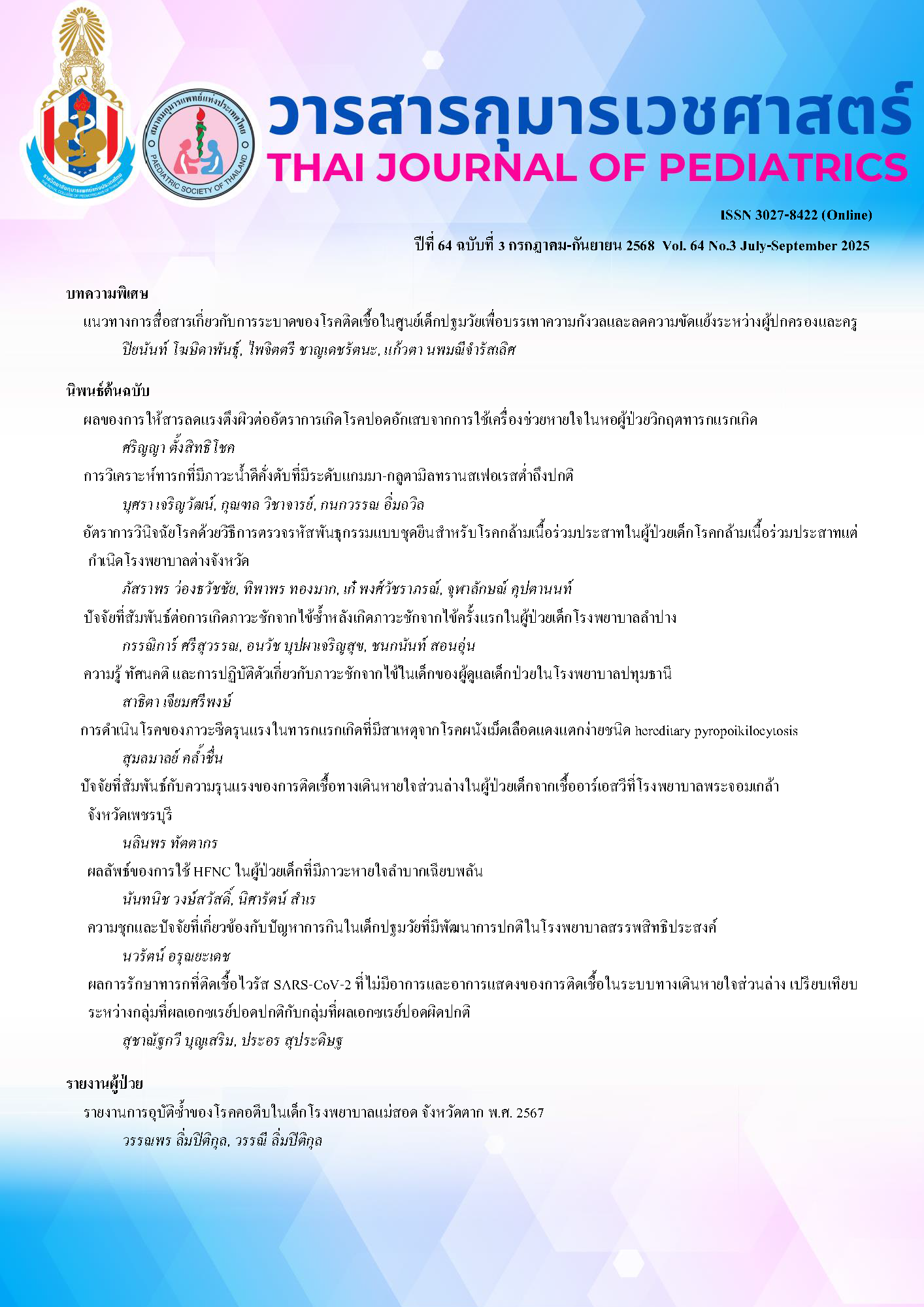Clinical outcomes of using high-flow nasal cannula (HFNC) in pediatric patients with acute respiratory distress: A retrospective study.
Keywords:
High flow nasal cannula (HFNC), Respiratory distress in pediatric patientAbstract
Background: Respiratory distress is an emergency event that requires immediate diagnosis and treatment. Ahigh-flow nasal cannula (HFNC) is widely used as an alternative method for a noninvasive respiratory support. Satun Hospital started implementing HFNC in the pediatric department in 2017.
Objectives: This study aimed to evaluate the outcomes of HFNC in treating respiratory distress in pediatric patients.
Methods: This retrospective study collected data from pediatric patients aged one month to 15 years old who were admitted to the hospital between January 1, 2022 and December 31, 2024. Patients with respiratory distress by WHO criteria receiving treatment with HFNC were included for chart reviews. A total 304 pediatric patients were included. They were devided into 2 groups, those succeeded from HFNC treatment (success group) and those developed respiratory failure (failure group). Fisher's exact test was used to evaluate the differences between the 2 groups. Factors associated with failure were analyzed using logistic regression. p value < 0.05 was considered statistically significant.
Results: The success rate of HFNC treatment in pediatric patients with respiratory distress in 2022-2024 was 93.6% (284 of 304 events). The majority of pediatric patients aged 1-15 years (66.8%). The most common cause of respiratory distress was pneumonia (44.4%). The median length of hospital stay was 5 days. The mean duration of HFNC was 44.5 hours. It was found that after HFNC treatment, the respiratory rate was reduced and the heart rate decreased (p value < 0.001) and the oxygen saturation value increased (p value 0.02). The factors affecting the failure of HFNC treatment were age < 1 year (p value < 0.001), the cause of hospitalization was sepsis-related (p value < 0.001) and congestive heart failure (p value 0.008). The factors affecting the success of HFNC use were asthma (p value 0.08) and hospitalization with the main disease being exacerbation of asthma (p value 0.012).
Conclusion: HFNC treatment in children with respiratory distress had good efficacy. Consideration of early treatment of respiratory distress with HFNC could reduce the chance of intubation and can reduce clinical symptoms.
Downloads
References
Challands J, Brooks K. Paediatric respiratory distress. BJA Educ. 2019;19:350-6.
Hasan R, Rhodes J, Thamthitiwat S, Olsen SJ, Prapasiri P, Naorat S, et al. Incidence and etiology of acute lower respiratory tract infections in hospitalized children younger than 5 years in rural Thailand. Pediatr Infect Dis J. 2014;33:e45-52.
อัตราป่วยตายโรคปอดบวมในเด็กไทย อายุ 1 เดือน ถึง 5 ปี บริบูรณ์ [Internet]. 2024 [cited 11 Feb 2024].Available.from:.https://hdcservice..go.th/hdc/reports/report.php?cat_id=3dc2d92087cdc5b585eb8c0904691399&id=7e5ba3f0ff6590f168f967a3f355914a.
Sajith K, Bala R. Humidified high flow nasal canula oxygen therapy in children – a narrative review. J Pediatr Crit Care. 2016;3:29-34.
เฉลิมไทย เอกศิลป์. การรักษาด้วย High flow nasal canula ในเด็ก. ใน: ดุสิต สถาวร,ครรชิต ปิยะเวชวิรัตน์, สหดล ปุญญถาวร, บรรณาธิการ. The Acute Care. กรุงเทพฯ:บียอนด์ เอ็นเทอร์ไพรซ์; 2558.387-96.
Ingvilid BM, Peter D, Knut O. High flow nasal canula in children: A literature review. Scan J Trauma Resusc Emerg Med. 2016;24:1-12.
Ji – Won K. High –flow nasal canula oxygen therapy in children: A clinical review. Clinical and Experimental Pediatrics. 2020;63:3-7.
สญมพร ชอบธรรม, พรมนัส พันธุ์สุจริตไทย. ผลกระทบทางคลินิกของการใช้ออกซิเจนเสริมชนิดอัตราการไหลสูงต่อการรักษาผู้ป่วยเด็กติดเชื้อทางเดินหายใจส่วนล่างในโรงพยาบาลสระบุรี. วารสารกุมารเวชศาสตร์. 2562;58:88-94.
ยุวดีคงนก. เปรียบเทียบการรักษาผู้ป่วยติดเชื้อทางเดินหายใจส่วนล่างและมีภาวะหายใจลำบากด้วยการให้ High flow nasal cannula กับการรักษาด้วยออกซิเจนมาตรฐาน. วารสารวิชาการสำนักงานสาธารณสุขจังหวัดมหาสารคาม. 2564;5:1-10.
Can FK, Anil AB, Anil M, Zengin N, Bal A, Bicilioglu Y, et al. Impact of high-flow nasal cannula therapy in quality improvement and clinical outcomes in a non-invasive ventilation device-free pediatric intensive care unit. Indian Pediatr. 2017;54:835-40.
Milési C, Pierre AF, Deho A, Pouyau R, Liet JM, Guillot C, et al. A multicenter randomized controlled trial of a 3-L/kg/min versus 2-L/kg/min high-flow nasal cannula flow rate in young infants with severe viral bronchiolitis (TRAMONTANE 2). Intensive Care Med. 2018;44:1870-8.
Sitthikarnkha P, Samransamruajkit R, Prapphal N, Deerojanawong J, Sritippayawan S. High-flow nasal cannula versus conventional oxygen therapy in children with respiratory distress. Indian J Crit Care Med. 2018;22:321-5.
Zhao H, Wang H, Sun F, Lyu S, An Y. High-flow nasal cannula oxygen therapy is superior toconventional oxygen therapy but not to noninvasive mechanical ventilation on intubation rate: A systematic review and meta-analysis. Crit Care. 2017;21:184.
นุชรดา สามพายวรกิจ. ประสิทธิผลของการใช้ High flow nasal canula (HFNC) ในผู้ป่วยเด็กที่มีภาวะหายใจลำบาก โรงพยาบาล ๕๐ พรรษา มหาวชิราลงกรณ์ วารสารโรงพยาบาลหนองคาย. 2566;1:1-22.
Wu JH, Wang CC, Lu FL, Huang SC, Wu ET. The applications of high-flow nasal cannulas in pediatric intensive care units in Taiwan. J Formos Med Assoc. 2024;S0929-6646:00244-4.
จุฑามาศ สุจริต.ประสิทธิผลของการใช้ High-Flow Nasal Cannula ในผู้ป่วยเด็กที่มีภาวะหายใจลำบากในโรงพยาบาลชุมชนระดับทุติยภูมิ. วารสารกุมารเวชศาสตร์. 2567;3 : 61-80.
ศุภัคษร พิมพ์จันทร์. ผลการรักษาผู้ป่วยเด็กที่มีภาวะหายใจลำบากด้วยการใช้เครื่องให้อากาศผสมออกซิเจนอัตราการไหลสูงในโรงพยาบาลหนองบัวแดง. ชัยภูมิเวชสาร. 2565;42:47-54.
Asseri AA, AlQahtani YA, Alhanshani AA, Ali GH, Alhelali I. Indications and safety of high flow nasal cannula in pediatric intensive care unit: Retrospective single center experience in Saudi Arabia. Pediatric Health Med Ther. 2021;12:431-7.
Chupinijrobkob P. Effectiveness of implementing evidence-based nursing practice for pediatric patients receiving heated humidified high-flow nasal cannula (HHHFNC). Thammasat University Hospital Journal Online. 2023;8:28-45.
อัจจิมาวดี พงศ์ดารา. ผลการใช้ High Flow Nasal Cannula (HFNC) ในผู้ป่วยเด็กที่มีภาวะหายใจลำบาก. วารสารกุมารเวชศาสตร์. 2565;58:175-81.
Slain KN, Shein SL, Rotta AT. The use of high-flow nasal cannula in the pediatric emergencydepartment. J Pediatr (Rio J). 2017;93:s36-45.
ภัณฑิลา สิทธิ์การค้า. การศึกษาเปรียบเทียบการรักษาผู้ป่วยเด็กที่มีภาวะหายใจลำบากด้วยการให้ High flow nasal cannula กับการรักษาด้วยออกซิเจนตามการรักษาปกติ [Internet]. 2563 [cited 15 April 2024]. Available from:https://www.thaipedlung.org/download/Chula_Panthila_Edited.pdf.
Iplik G, Yildizdas D, Yontem A. Clinical factors of high-flow nasal cannula oxygen success in children. J Pediatr Intensive Care. 2021;12:71-8.
Ballestero Y, De Pedro J, Portillo N, Martinez-Mugica O, Arana-Arri E, Benito J. Pilot clinical trial of high-flow oxygen therapy in children with asthma in the emergency service. J Pediatr. 2018;194:204-10.e3.
Baudin F, Buisson A, Vanel B, Massenavette B, Pouyau R, Javouhey E. Nasal high flow in management of children with status asthmaticus: A retrospective observational study. Ann Intensive Care. 2017;7:55.
Downloads
Published
How to Cite
Issue
Section
License
Copyright (c) 2025 The Royal College of Pediatricians Of Thailand

This work is licensed under a Creative Commons Attribution-NonCommercial-NoDerivatives 4.0 International License.



